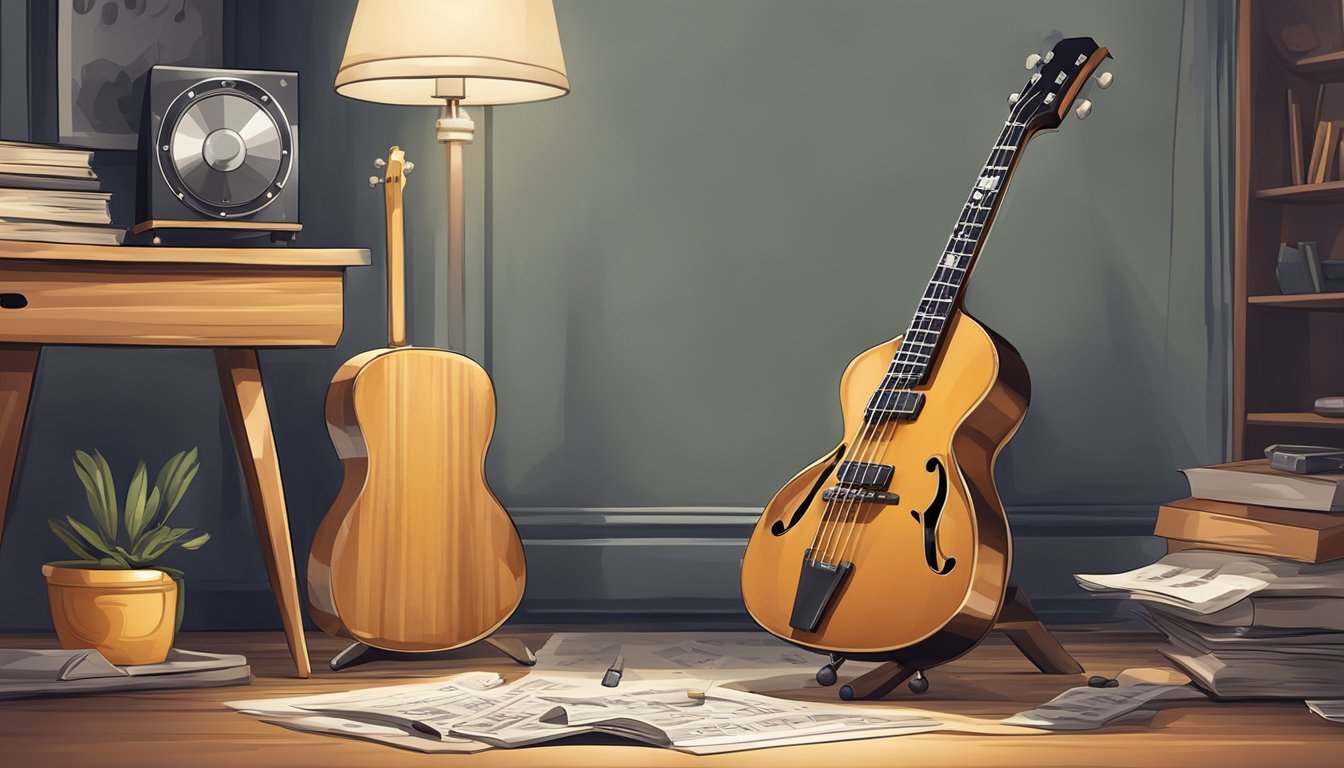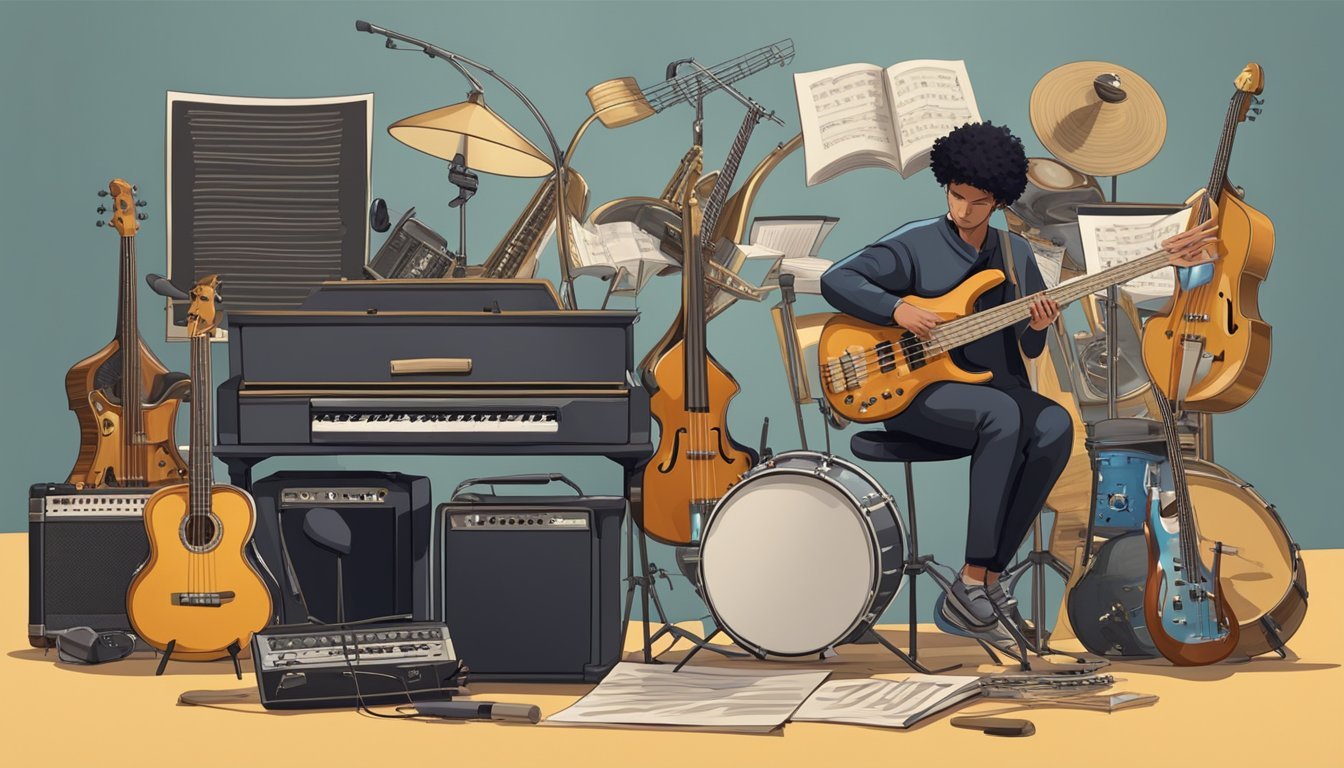Learning to play the bass guitar is an exciting journey.
Many beginners wonder how long it takes to become proficient. You can typically learn the bass guitar in a few months to several years, depending on your practice habits and goals.

When you start, you’ll grasp the basics quickly, like learning notes and scales.
As you continue, mastering techniques and building your skills comes with time and dedication.
Whether you want to play for fun or aim for a professional level, understanding your personal timeline will keep you motivated on this musical path.
Key Takeaways
- You can learn the basics in a few months with consistent practice.
- Advancing your skills is a gradual process that requires persistence.
- Setting clear goals helps you navigate your learning journey.
Getting Started with the Bass Guitar
Starting your journey with the bass guitar can be exciting and rewarding.
You’ll need to consider the type of bass to choose, how to set it up, and the crucial role of rhythm in your playing.
Choosing the Right Bass
When picking your first bass guitar, think about what feels comfortable for you.
There are two main types: electric and acoustic bass guitars.
Electric basses are popular for their versatility and ability to connect to amplifiers.
Consider the scale length.
A short scale is easier for beginners, while a long scale offers a deeper sound.
Additionally, check the number of strings.
Most players start with a four-string bass.
Don’t forget to visit a local music store to try different models.
It helps you find the right fit.
Playing a few instruments will give you a sense of what you like best.
Basic Setup and Accessories
Setting up your bass guitar properly is essential for a good playing experience.
First, ensure your bass is tuned.
You can use an electronic tuner or a tuning app.
Next, think about accessories.
A decent bass strap is important for comfort.
If you plan to play standing up, a strap will help you feel more secure.
You might also want some picks if you prefer that style of playing.
Don’t forget a gig bag to protect your bass when you aren’t using it.
These accessories make your playing easier and more fun.
Understanding the Role of Rhythm
Rhythm is a key part of music, especially on the bass.
Your job is to keep the groove with the drummer.
You’ll often play along with the beat, creating a solid foundation for the song.
Start by practicing simple bass lines.
Focus on timing and making sure you stay in sync with the music.
Listening to various music styles can help you understand different rhythms.
Try practicing with a metronome.
This tool can enhance your timing and help you stay steady.
Overall, getting comfortable with rhythm is essential to becoming a great bass player.
Learning the Fundamentals
Getting a solid grip on the basics is key to mastering the bass guitar.
Focusing on music theory, effective practice routines, and muscle memory will set you up for success.
Here’s what you need to know.
Music Theory for Bass Players
Understanding music theory is important for playing the bass.
Start by learning how to read music and understand notes. Key concepts include:
- Scales: These form the foundation of melody and harmony.
- Chord progressions: Knowing how chords work together helps you create engaging basslines.
- Intervals: Recognizing the distance between notes aids in finger placement.
By grasping these concepts, you’ll be able to play with others and improvise.
This knowledge turns you from just a player into a musician who understands the music.
Developing Effective Practice Routines
Creating a consistent practice routine can greatly improve your skills.
Aim for short, focused sessions rather than long, tiring ones.
Here’s a simple routine:
- Warm-up: Start with scales to loosen your fingers.
- Techniques: Spend time on specific skills, like finger placement or slapping.
- Songs: Practice your favorite tunes to apply what you’ve learned.
- Review: End your session by playing something you know well.
Set realistic goals, like learning a new song each week.
This keeps you motivated and helps you see progress over time.
Building Muscle Memory
Developing muscle memory is crucial for any player.
It allows you to play more smoothly and confidently.
Here are some tips:
- Repetition: The more you practice a movement, the easier it becomes. Repeat scales and exercises often.
- Slow it down: Start slowly to ensure accuracy, then gradually increase your speed.
- Break it up: Focus on challenging sections of a song before trying the whole piece.
With consistent practice, your fingers will start moving instinctively, letting you focus more on the music.
Building this skill will make playing feel natural.
Techniques and Application

Getting comfortable with playing bass takes practice, especially focusing on specific techniques and how you apply them in music.
Mastering these techniques can help you create solid basslines and even explore advanced styles.
Finger Techniques and Exercises
Finger technique is essential for playing bass smoothly.
Start with simple exercises like the one-finger-per-fret rule.
This means using a separate finger for each fret while playing notes in a scale or a line.
Practice finger slides and hammer-ons to enhance fluidity.
Perform exercises with a metronome to keep your timing tight.
You can also drill your fingers on simple patterns, like playing a major scale up and down.
Here are some effective exercises to try:
- Chromatic Scales: Play four notes on each fret.
- Alternate Picking: Use both your index and middle finger while plucking.
Consistency is key.
Aim to practice these exercises daily to build muscle memory.
Playing Scales and Creating Melodies
Playing scales is a fundamental skill for developing your bass lines.
Start with major and minor scales, as they form the backbone of most melodies.
Practicing scales will help you learn the notes on the fretboard, making it easier to create basslines.
Once you’re comfortable, try to create a bassline using those scales.
Focus on rhythm as much as melody.
You might even want to experiment with patterns, like playing the root note, then jumping to the fifth.
To further explore, link scales with chord progressions.
Understanding how your bass fits with the chords will give your playing richness.
Introduction to Slap Bass
Slap bass adds a unique sound that can capture attention.
Start by using your thumb for the slap technique, hitting the string hard at the end.
This creates a percussive sound that cuts through the mix.
Next, learn the pop technique.
Here, you pull a string with your fingers, making a sharper note.
Combine these techniques to form rhythmic patterns.
Focus on playing along with songs that feature slap bass, as this can guide you.
Practice consistently.
Slap bass requires strength and timing, so focus on hitting the strings cleanly.
Once you master these basics, your playing will stand out in any group setting.
Advancing Your Skills

As you learn bass guitar, advancing your skills is crucial for becoming a better player.
Engaging with others and exploring different music can take your abilities to the next level.
Here are some key ways to do just that.
Joining a Band or Ensemble
Playing with others is one of the best ways to improve.
When you join a band or ensemble, you get real-time feedback and can learn from more experienced players.
You’ll also develop a sense of timing and rhythm.
Bassists often provide the backbone of a band, so your role is essential.
It’s not just about your skills; it’s also about communication and teamwork.
Look for local groups, whether in your school, community centers, or online forums.
Regular practice with others helps reinforce what you’ve learned.
Plus, it’s a lot of fun to share your music journey!
Exploring Different Music Genres
Diving into various music genres can broaden your skills.
Each genre presents unique styles and techniques.
For example, jazz bass involves intricate rhythms and improvisation, while rock focuses on driving bass lines.
Try listening to different styles, and don’t hesitate to mimic the bass players you admire.
You’ll develop versatility, making you a more adaptable musician.
This skill is especially important in bands, where you may need to play various styles.
Consider taking lessons focused on different genres.
You could also find online tutorials that break down popular bass lines for various styles.
This way, you can learn bass in a fun and engaging way.
Becoming a Professional Bassist
If you dream of becoming a professional bassist, it’s time to invest in your craft.
This path requires dedication and a strategic approach.
Start by building a broad repertoire.
You need to know many songs across genres.
Networking is also crucial; attend music events and connect with other musicians.
Consider formal music education or private lessons, focusing on aspects like theory and performance.
Many pros also teach, so you might learn tips directly from their experiences.
With consistent practice and passion, you can work your way toward a career as a professional bassist, whether in bands, studios, or live performances.
Frequently Asked Questions

When learning the bass guitar, you might have some common questions.
Let’s dive into a few frequently asked queries to help you understand the learning journey better.
Some beginners wonder about the best way to start and whether they need prior musical experience.
It’s important to focus on foundational skills, so make sure to learn basic bass guitar techniques that will set you up for success as you progress.
Additionally, practicing regularly and listening to various styles of music can significantly enhance your understanding of rhythm and melody, making your learning experience more enjoyable.
Can you learn to play the bass guitar in just a month?
Yes, it is possible to learn some basic skills on the bass guitar in a month.
If you practice regularly, you could play simple songs and know some notes on the fretboard within that time.
What’s the learning curve like for the bass compared to the guitar?
The learning curve for bass guitar is often seen as more straightforward than for the regular guitar.
Bass focuses primarily on rhythm and groove, while guitar involves more chords and melodies.
Are there any age limits to starting to learn the bass guitar?
There are no age limits when it comes to learning the bass guitar.
People of all ages start playing, from kids to seniors.
It’s never too late to pick up a new skill.
Do you think it’s simpler to pick up bass guitar after knowing how to play a six-string?
Yes, if you already play six-string guitar, learning bass can be easier.
You’ll have a grasp of music theory, finger positioning, and rhythm that will help you on bass.
How do bass guitar lessons help with the learning process?
Bass guitar lessons provide structure and guidance.
A good teacher can help you focus on the essential techniques, provide feedback, and keep you motivated.
Would you say the bass guitar is one of the tougher instruments to master?
The bass guitar can be challenging, like any other instrument.
Mastering it takes time and practice.
You will need to develop a good sense of timing and rhythm.

